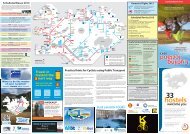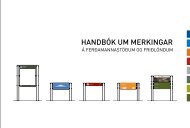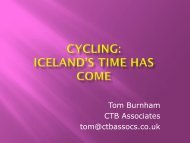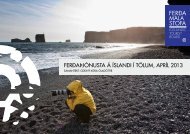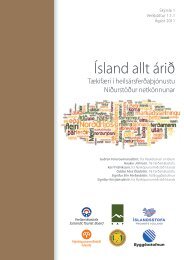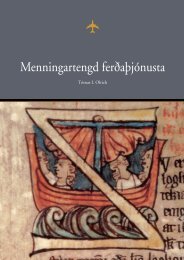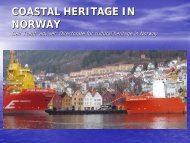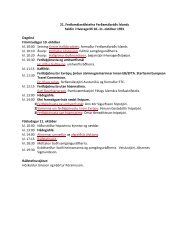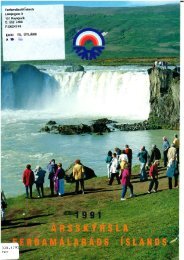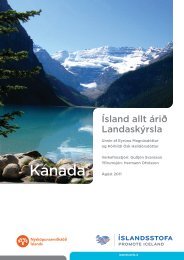Untitled
Untitled
Untitled
Create successful ePaper yourself
Turn your PDF publications into a flip-book with our unique Google optimized e-Paper software.
Images of Iceland as a tourist destination, as they appear through<br />
branding, in promotion or other material is, of course, not the same as<br />
images that particular tourists may have or construct. In a recent study<br />
Bjarnadóttir investigated destination image and Iceland as a tourist<br />
destination, through Danish tourists who have visited Iceland and tour<br />
guides working in Iceland. According to her, the study shows that:<br />
[M]ost of the tourists expected to experience nature in Iceland, and most<br />
tourists were definitely not disappointed. According to the guides,<br />
nature, purity and diversity are strong motives for the destination image<br />
of Iceland. Surprisingly for many tourists, the Icelandic society is more<br />
modern than they thought. /…/ Before their visit, the Danish tourists´<br />
destination image of Iceland had to do with nature, hot springs,<br />
volcanoes, and, in some cases, cultural phenomena such as Icelandic<br />
sagas and history. The nature became the middle of the tourist<br />
experience, although different parts of nature appealed to different<br />
tourists. Aurora borealis, purity, The Golden Circle, black fields of lava,<br />
waterfalls and the constant change of scenario are some of the parts<br />
mentioned by the Danish tourists (Bjarnadóttir 2007, p. 103).<br />
The powers of cartographic tourism and tourist representation<br />
should now be clear. The cartography gives the tourist product a tangible<br />
quality which it, in certain ways, lacks itself. By ontologically<br />
transforming the intangible tourist experience, bounded and fixed to certain<br />
locations, into a mobile form, comes an imaginative ability to attract and<br />
influence tourist behaviours, experiences, motivations and consumption<br />
elsewhere. Even “nothing” is possible to map:<br />
A certain “nothing” was also mentioned to be part of the touristic<br />
experience and left a permanent mark on the tourists´ post visit image of<br />
Iceland. This “nothing” refers to the Icelandic landscape, which is<br />
somewhat different from what the Danish tourists are used to. The naked<br />
wilderness and the scattered population contrast the manmade<br />
surroundings and heavily populated cities of the world. “Nothing”<br />
becomes something positive and desirable and boosts the tourists´<br />
experience of nature (Bjarnadóttir 2007, p. 103).<br />
It therefore comes as no surprise that research on tourism destination<br />
images, or what is also referred to as “destination imagery”, has<br />
traditionally been assigned an important role and function in the travel<br />
purchase decision making. The map of tourist imagination again meets the<br />
territory of tourism so that:<br />
50



